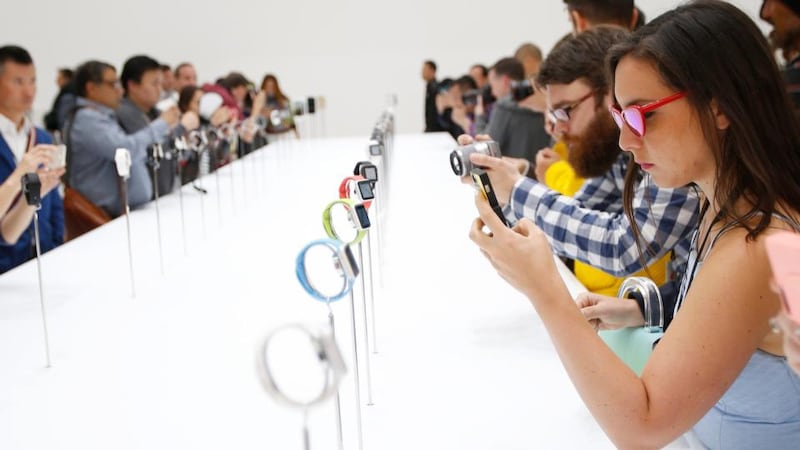In what was one of the most keenly anticipated tech events in recent years, Apple chief executive Tim Cook yesterday unveiled a host of new devices and technologies at the Flint Centre for the Performing Arts in Cupertino, California, not far from Apple’s headquarters. Even with a heavily rumoured “surprise” performance from U2, debuting a track from their new album, it was the new gadgets that provided most of the glamour and wowed the large crowd of guests and technology journalists.
With two new iPhones and an entirely new wearable device, dubbed the Apple Watch, as well as announcing a new in mobile payments, it was the company’s most significant such event since founder Steve Jobs unveiled the iPad in 2010, and challenged the widespread perception that the company was unable to innovate without Jobs, who died in October 2011.
The big announcement was the unveiling of the Apple Watch, which has been the subject of rumours for more than two years but which had not seen publicly before yesterday’s event. It is the company’s first new product category since the iPad.

“Apple introduced the world to several category-defining products: the Mac, iPod, iPhone and iPad,” said Mr Cook. “It’s the most personal product we’ve ever made.”
Coming in three editions – Apple Watch, Apple Watch Sport and Apple Watch Edition – and available in two sizes, 38mm and 42 mm, the device features a a scratch-resistant sapphire screen and health and fitness monitoring sensors for lifestyle tracking.
Fashion accessory With the different designs and numerous different straps, the computer giant is marketing the watch as a fashion accessory as much as a gadget, a fact reflected in the number of figures from fashion and entertainment who attended the event, including singers Gwen Stefani and will.i.am and model Lily Cole.
The new iPhones follow the industry trend of larger screen sizes, with the iPhone 6 moving to a 4.7-inch screen, compared with the previous generation’s 4-inch screen, and an even larger 5.5-inch model, the iPhone 6 Plus. The iPhone 6 Plus is a so-called “phablet”, a device that sits between smartphones and tablets in terms of screen real estate.
Despite the size appearing unwieldy, Samsung has had considerable success with the Galaxy Note series of phablets. Both devices are even thinner than the previous generation iPhone.
The devices will go on sale on Friday, September 19th, in the United States and select other countries, and before the end of the year in Ireland, with prices beginning at $199 (€154) for the iPhone 6 and $299 for the iPhone 6 Plus. Supply of the iPhone Plus 6 is expected to be constrained at first.
The third major announcement was the launch of Apple Pay, a new service that the company says “will transform mobile payments with an easy, secure and private way to pay” by allowing users to pay by simply waving their iPhone or Apple Watch at a payment terminal.
Apple Pay works with iPhone 6 and iPhone 6 Plus through a NFC antenna design, a chip called the Secure Element, and verification through the finger- recognition Touch ID button. Apple is partnering with all the major credit card companies and many major banks, as well as dozens or retailers and food chains such as Bloomingdale’s, Disney Store, Macy’s, McDonald’s and Subway. Apple Pay will be US-only at launch.
The event followed the controversy over the theft of celebrities’ private images from the company’s iCloud service, which backs up users’ photographs and data to servers, but executives were at pains to confirm that the new Apple Pay service was even more secure than using credit cards.
The choice of venue was a pointed one – it was at the Flint Centre that Apple founder Steve Jobs unveiled the first Macintosh computer in January 1984, changing the shape of computing history in the process.
‘Key day for Apple’
The echoes of that event could be felt throughout yesterday’s keynote, with Mr Cook beginning the event by recalling that launch: “It is great to be back in the Flint Centre . . . On this stage, Steve introduced the Macintosh. Today, we have some amazing products to share with you, and we think at the end of the day, you will think that this will be a key day for Apple”.
The unprecedented scale of the media presence, with the auditorium packed with more than 2,000 journalists from around the world, reflected Apple’s determination to regain the perception that it is the most innovative and influential technology firm in the world.
In recent years, South Korean giant Samsung has successfully eaten into sales of Apple devices, while Google’s various so-called “moonshot” projects, such as self-driving cars and smartglasses, are in contrast to Apple’s lack of entirely new devices in recent years. Yesterday’s launch event will go some way towards establishing Apple as the technology’s leading innovators.









